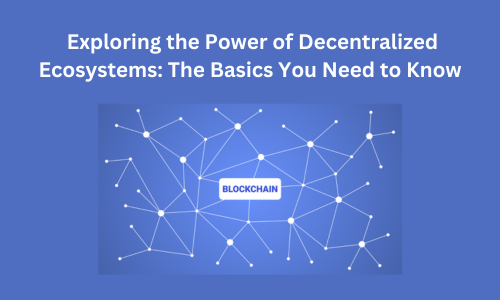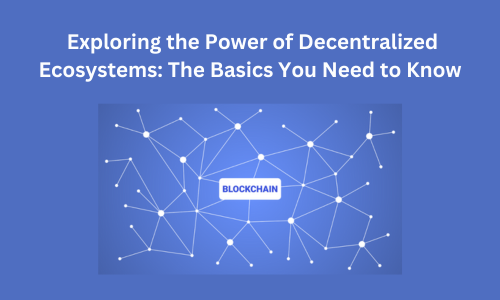


In an increasingly digital world, the concept of decentralization is rapidly gaining traction. Whether you're interested in cryptocurrencies, digital governance, or the future of the internet, understanding decentralized ecosystems is essential. These ecosystems promise to reshape industries by offering greater security, transparency, and user autonomy. But what exactly are decentralized ecosystems, and why are they so important? In this article, we'll break down the basics and explore the core components that make these systems so revolutionary.
At its core, a decentralized ecosystem is a system where control and decision-making are distributed across a network rather than being centralized in a single entity. Unlike traditional centralized systems—where a single authority has control over data, processes, and rules—decentralized systems operate without a central point of control. This distribution of power leads to systems that are more resilient, transparent, and often more democratic.
Decentralized ecosystems are becoming increasingly popular because they address many of the shortcomings of centralized systems. For example, they can reduce the risk of data breaches, eliminate single points of failure, and provide users with greater control over their information.
To understand the significance of decentralized ecosystems, it's important to contrast them with centralized systems. In a centralized system, decision-making and control are concentrated in a single entity, such as a government, corporation, or bank. This model is efficient for managing large organizations but has notable downsides, including vulnerability to corruption, censorship, and security breaches.
Decentralized systems, on the other hand, distribute control across a network of participants. This means that no single entity has complete control, making the system more resistant to attacks and corruption. For example, while traditional banking systems are centralized, cryptocurrencies like Bitcoin operate on a decentralized network, where transactions are validated by multiple nodes rather than a central authority.
Blockchain technology is the foundation of most decentralized ecosystems. A blockchain is a distributed ledger that records transactions across a network of computers. Each transaction is stored in a "block," which is linked to the previous block, forming a "chain." This structure ensures that the data is secure, transparent, and immutable.
One of the key features of blockchain is its use of cryptography to secure transactions. This means that once data is recorded on a blockchain, it cannot be altered or deleted without the consensus of the network. This makes blockchain ideal for applications where security and transparency are critical, such as financial transactions, supply chain management, and digital identity.
In decentralized ecosystems, trust is not placed in a central authority but in the system itself. This trust is maintained through consensus mechanisms, which are protocols that ensure all participants in the network agree on the state of the blockchain.
There are several types of consensus mechanisms, each with its own strengths and weaknesses:
Proof of Work (PoW): Used by Bitcoin, PoW requires participants (miners) to solve complex mathematical problems to validate transactions. While secure, PoW is energy-intensive and has scalability issues.
Proof of Stake (PoS): PoS allows participants to validate transactions based on the number of coins they hold and are willing to "stake" as collateral. PoS is more energy-efficient than PoW and is used by networks like Ethereum 2.0.
Delegated Proof of Stake (DPoS): DPoS is a variation of PoS where participants vote for a small number of delegates who validate transactions on their behalf. This approach is faster and more scalable but introduces a level of centralization.
These consensus mechanisms are crucial because they ensure the integrity of decentralized ecosystems without the need for a central authority.
To fully understand decentralized ecosystems, it's important to explore their key components:
Cryptocurrencies and Tokens: Cryptocurrencies like Bitcoin and Ethereum are the native currencies of decentralized ecosystems. They enable secure, peer-to-peer transactions without intermediaries. Tokens, on the other hand, represent assets or utilities within a decentralized system. For example, utility tokens can be used to access services within a network, while governance tokens allow holders to vote on decisions affecting the ecosystem.
Smart Contracts: Smart contracts are self-executing contracts with the terms of the agreement directly written into code. They automatically enforce and execute agreements when certain conditions are met, eliminating the need for intermediaries. Smart contracts are a cornerstone of decentralized applications (dApps) and are widely used in decentralized finance (DeFi) platforms.
Decentralized Applications (dApps): dApps are applications that run on decentralized networks rather than centralized servers. They offer greater transparency, security, and user control compared to traditional apps. Examples of popular dApps include Uniswap, a decentralized exchange, and Aave, a decentralized lending platform.
Decentralized Autonomous Organizations (DAOs): DAOs are organizations that operate on a decentralized network and are governed by smart contracts. Decisions within a DAO are made collectively by its members through a voting process. DAOs are an innovative approach to governance, enabling decentralized decision-making without the need for a central authority.
Advantages:
Security and Resistance to Censorship: Decentralized systems are inherently more secure because they lack a single point of failure. They are also more resistant to censorship since no single entity controls the network.
User Control and Data Ownership: In decentralized ecosystems, users have greater control over their data and digital assets. This is in stark contrast to centralized systems, where users often have to relinquish control of their data to a central authority.
Innovation: Decentralized ecosystems are fertile ground for innovation, particularly in areas like finance, governance, and digital identity. They enable the creation of new business models and services that were previously not possible.
Challenges:
Scalability: Decentralized systems often struggle with scalability, particularly in terms of transaction speed and throughput. For example, the Bitcoin network can only process a limited number of transactions per second, which can lead to delays and high fees during periods of high demand.
Regulatory Challenges: The decentralized nature of these ecosystems makes them difficult to regulate, leading to uncertainty in legal and regulatory frameworks. This is a significant challenge for mainstream adoption.
User Experience: Decentralized systems can be complex and difficult for the average user to navigate. Improving user experience and accessibility is crucial for widespread adoption.
Bitcoin and Ethereum: Bitcoin is the first and most well-known decentralized cryptocurrency. It operates on a decentralized network of nodes that validate transactions without the need for a central authority. Ethereum, on the other hand, has expanded the concept of decentralization by introducing smart contracts, enabling the creation of decentralized applications and services.
Decentralized Finance (DeFi): DeFi is a rapidly growing sector that aims to recreate traditional financial services—such as lending, borrowing, and trading—on decentralized platforms. Popular DeFi platforms like Uniswap and Aave enable users to trade assets and earn interest without relying on traditional financial institutions.
Web3 and the Future of the Internet: Decentralized ecosystems are paving the way for Web3, a new version of the internet where users have greater control over their data and online interactions. Projects like IPFS (InterPlanetary File System) and Filecoin are building decentralized storage solutions that could revolutionize how we store and share data online.
The future of decentralized ecosystems is full of potential, but it also faces significant challenges. As these systems continue to evolve, they could disrupt various industries, from finance to healthcare, and beyond. Emerging trends like non-fungible tokens (NFTs) and decentralized identity solutions are already showing how decentralization can extend beyond cryptocurrencies and into new areas.
However, for decentralized ecosystems to reach their full potential, they must overcome hurdles such as scalability, regulation, and user experience. As technology continues to advance, it's likely that we'll see new solutions to these challenges, paving the way for a more decentralized and equitable digital world.
Decentralized ecosystems represent a fundamental shift in how we think about control, ownership, and trust in the digital age. By distributing power across a network rather than concentrating it in a single entity, these systems offer a more secure, transparent, and democratic alternative to traditional centralized systems. As you continue to explore this exciting field, you'll find that the possibilities for innovation are virtually limitless.
Whether you're a newcomer to the world of decentralization or a seasoned enthusiast, there's always more to learn and discover. Dive deeper, explore the possibilities, and stay informed about the developments that are shaping the future of decentralized ecosystems.
Disclaimer: This article is provided for informational purposes only. It is not offered or intended to be used as legal, tax, investment, financial, or other advice.
Featured Image - Pixabay
